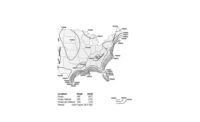Structural engineers are welcoming the 2014 update of the 519-page "American Concrete Institute's Building Code Requirements for Structural Concrete (ACI 318-14)," released late last month. The reorganized and reformatted standard, designed to be simpler and more intuitive for users, represents the first major overhaul since 1969.
"It was a Herculean effort on the part of the ACI 318 committee to do this," says Randall W. Poston, an Austin, Texas-based structural consultant and the committee chairman. "We think [the new code] is a huge improvement," he adds.
Over the six years of its development, the standard's 41 voting main-committee members, 42 voting subcommittee members and others logged a total of 96,000 hours of volunteer time, which translates to an excess of $14 million worth of pro bono work. "The number is staggering," says Ron Klemencic, chairman and CEO of Magnusson Klemencic Associates and one of the main committee members.
Major Departure
In a major departure, the overhaul presents design and detailing requirements for structural systems or for individual members—foundations, slabs, walls, columns, beams, etc.—in chapters devoted to those individual subjects. Previously, for each member or system, flexure was in one chapter, shear in another, reinforcement steel detailing in a third and so on.
In addition, the 27 chapters are ordered to shadow the process and chronology of design and construction.
While the new format may "seem like an obvious way to organize the code, to grasp the significance of the change, one must reflect on the 50 years of prior code development, where there was a mixture of members, analysis and structural mechanics," says Klemencic.
ACI 318-14 is 16 pages longer than ACI 318–11, but it includes two completely new chapters: one on structural system requirements and the other on diaphragms. A stand-alone chapter on construction documents and inspection is new in the sense that, previously, the provisions' various design requirements were scattered throughout the publication. In ACI 318-14, they are in one location to make the requirements, which were never clear, easier to find, says Poston.
Structural engineer Ronald O. Hamburger, a senior principal of Simpson Gumpertz & Heger, has reservations about the reorganization. "It may ultimately be beneficial for engineers [but] will result in a lot of initial confusion and mistakes on the part of engineers who are used to the old format," says Hamburger.
However, Poston claims the new format is "not a huge change for seasoned professionals, but it is a lot easier for newcomers and students."
The standard can be purchased online at www.concrete.org. The cost is $149 for ACI members and $249.50 for others.
ACI 318-14, which also includes the "Commentary on Building Code Requirements for Structural Concrete (ACI 318R-14)," is adopted in whole or in part by 21 nations outside the U.S. Further, it is under development in several African nations, according to ACI.



Post a comment to this article
Report Abusive Comment